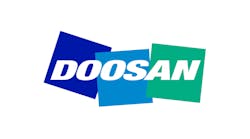Starrett's Advanced Technology Division produces most of the company's circuit boards for its electronic products as economically as an outside firm would, and making the boards in-house ensures accuracy and ruggedness.
A mix of old and new processes best suits Starrett's manufacturing needs, so it is not surprising to see lines of manual knee mills and hand-assembly operations along with CNC machine cells and EDMs in the company's plant.
The DataSure wireless data-collection system is one of the many innovations coming out of Starrett's Advanced Technology Division.
Starrett Gladiator bandsaw blades saved Saint-Gobain Abrasives about 30 percent in blade costs and increased its sawing productivity by 50 percent.
Laroy S. Starrett built his company on the idea of providing " something useful that people would want," and that business plan still drives The L.S. Starrett Co. (www.starrett.com) 125 years later. But it has evolved to meet the manufacturing needs of its customers today because, for Starrett, it is simply not enough to just provide high-precision measuring tools and saw blades.
Beyond its sterling reputation for quality, Starrett positions itself as a full-service tool company that offers a line of standard products and the capability to modify or re-engineer those products for specific applications coupled with a continuous flow of new, useful technology. In addition, the company continuously evaluates its manufacturing processes to find ways to cut costs and streamline production to provide cost-effective solutions for its customers, while also expediting just-in-time orders.
In evaluating processes, the company maps value streams and studies ways to improve manufacturing and eliminate waste, an effort spearheaded by its Lean Initiative team. A chief engineer, chief inspector, two methods engineers and a manager make up the team.
While the team finds some processes benefit from incorporating concepts such as lean and CNC cell manufacturing, it also has found that other processes are done best by using traditional manual methods. So it is not surprising to see lines of manual knee mills and hand-assembly operations close to CNC machine cells and EDMs.
"We don't add CNC equipment unless it will definitely improve a process," says Harold Bacon, Starrett works manager. "Our old equipment, in most instances, is fast and accurate and easily keeps up with production levels. But, if a new technology comes along that performs better than the old equipment, we will incorporate it."
Starrett's new Prosite Series of carpenter's protractors is one product line manufactured under the company's Lean Initiative. A cell that includes CNC machines and inspection personnel builds the tools from start to finish. However, Starrett also has manufacturing cells that allow one operator to run multiple machines for a variety of parts.
Along with cell operators, Starrett puts all employees, both supervisors and shopfloor workers, through its Lean 101 training course. The company believes an educated workforce increases the amount of useful suggestions and inputs offered to support its Lean Initiative.
In another instance of evaluating and improving its manufacturing processes, Starrett determined that farming out circuitboard work was not cost-effective because the company's Advanced Technology Division makes them just as economically as an outside firm. Producing the boards in-house also ensures they are accurate and rugged.
The Advanced Technology Division manufactures and assembles the lion's share of the company's electronic products, including its latest technology, a wireless datacollection system called DataSure. The system uses small radio packs that attach to any of Starrett's existing digital tools and transfer data to statistical process control (SPC) programs.
When users take measurements of machining operations, the DataSure radio pack sends the measurements to an SPC program, and the computer responds back to the radio pack, indicating a successful transmission. Operators then receive a confirming green light. If the acknowledgement is not received, DataSure stores and re-sends the measurement data until it is safely recorded. The repetitive sending of data ensures users that their data has been delivered. Because the data is recorded automatically, users do not have to do it manually, so measuring cycle times are reduced.
To prevent interference problems common with point-to-point radio systems and to make the system more robust, DataSure incorporates router units. These units provide alternate paths for radio frequencies to ensure precise reception, and each extends the system's range by 30-meter increments.
Saint-Gobain Abrasives (Norton) in Worcester, Mass., an abrasive products manufacturer, is one company using a separate technology recently developed by Starrett to cut its costs and improve efficiency. Norton's Superabrasives Division saves about 30 percent in costs associated with saw blades and has increased its sawing productivity by 50 percent by using Starrett's recently developed Gladiator blades.
The blades feature a bi-metal construction with a fatigue-resistant alloy steel backing that gives them long wear and heat control. The blades' teeth are tripletempered M42 high-speed steel with 8 percent cobalt (Rc 67-69) and up to a 12-degree rake angle. They cut more accurately and straighter than the blades Norton was using, so less material is needed as stock for machining operations.
Norton Superabrasives cuts round solids from tool steel, aluminum and stainless. Peter Wojnar, general supervisor of superabrasives, says the new Gladiator blades allow switching between the different metals with little or no setup time.
With two saws cutting two shifts per day, Wojnar says he relies heavily on Starrett's saw-maintenance program to provide sawing tune-ups and diagnostics. He also uses Starrett's gage repair and calibration program that he says helps him to meet ISO requirements.
The shop uses a lot of electronic bore gages and micrometers from Starrett that have to withstand a harsh manufacturing environment. "These mics and gages handle everything from dust to metal cutting fluids to measuring diamondabrasive grinding wheels," says Wojnar.
While Norton uses Starrett's new technology and service programs, Acton Research Corp., of Acton, Mass., relies on Starrett's Special Order Department. The department classifies special orders as "regular" or " oneoff." A regular special involves modifying a standard tool product, while a one-off is a custom solution, engineered and manufactured by the department. One-offs can involve anything from area-flow gages for jet-engine nozzles to diameter gages for measuring the lids of icecream containers.
Acton builds spectrometers that incorporate as many as three modified Starrett micrometer heads to control amounts of light that enter the units. Modifications might have Starrett grinding points and relocating adjusting screws on the heads. The Special Order Department also sets head tension to match Acton's specifications.
Lou Jacques, Acton materials manager, says Starrett modifies and delivers the heads on time. He said other measuring-tool suppliers could not meet delivery schedules.
An area-flow gage (in case) and one for measuring icecreamcontainer lids are two examples of gaging solutions engineered and manufactured by Starrett's Special Gage Division.
Spectrometers from Acton Research incorporate custom micrometer heads that Starrett's Special Order Department modifies for the application.
Measuring Medical
Filtrona Extrusion accurately checks its noninvasive, I.V. and suction medical tubing without deforming the product on a Starrett HE-350 comparator.
Technicians in New England Precision Grinding's metrology lab measure small, intricate needle patterns using Starrett optical comparators and overlays that further speed the process.
Filtrona Extrusion of Athol, Mass., and New England Precision Grinding (NEPG) Inc. in Holliston, Mass., manufacture for the medical market and accurately measure small, delicate and intricate components using Starrett optical comparators.
Filtrona conducts I.D., O.D. and 3 or 4-point checks on its noninvasive, I.V. and suction tubing on an HE-350 comparator. While the company holds tube tolerances to within thousands of an inch, the challenge is to confirm dimensions without deforming the product.
Prior to using the noncontact comparator, the company used handtools that made gaging difficult. Starrett's comparators offer Filtrona accuracies within 0.0001 in. with traceability to NIST.
Another important benefit of the HE-350, which performs half of the shop's gaging, is its ease of use. Filtrona often employs temporary labor, and the simple checking routines of the comparator reduce training time, says David Rathburn, plant manager at Filtrona. NEPG specializes in centerless grinding of medical-device components, exclusively wire for surgical procedures. Wire diameters run as small as 0.003 in. and as large as 0.062 in. and include features and transitions so small that they can not be seen by the naked eye.
"I can't imagine having to measure the wire components we make without using Starrett comparators," says Harold Greenberg, qualityassurance manager for NEPG. "It just couldn't be done because of the parts' tiny features."
The company has nine Starrett comparators, two of which are in its metrology lab, an HE-350 and Sigma HB-400. The systems enlarge the features of the stainless steel and nitinol needles and needle shanks and ensure the shop is holding its tolerances — ± 0.0001 in. and within 1 degree for angles. To further speed the measuring process, the lab uses overlays on its comparators, which, in some instances, reduces 4-hr inspection times down to 25 min. And the lab is especially fond of the comparators' quick-change lenses and surface lights mounted on center.
Global From The BeginningLaroy S. Starrett realized the value of globalization as early as 1900. It was then that he established distribution facilities in Europe, which propelled Starrett from a domestic to an international brand name, but the company did not stop there. After WW II, Arthur Starrett, the grandfather of current company president and CEO, Douglas A. Starrett, determined that global distribution was not enough. He decided that the company needed to manufacture internationally. As a result, he opened manufacturing facilities in Brazil and Scotland in the late 1950s to serve the South American and European markets. In 1997, Starrett opened a plant in China to serve that market and the Asian-Pacific markets."A strong manufacturing and support infrastructure drives the Starrett brand," says Doug Starrett. Being global has insulated the company from cyclical market downturns and positioned it for future growth. He further comments that the success of the company would not have been possible without the pride, dedication and innovation of Starrett personnel worldwide. |














